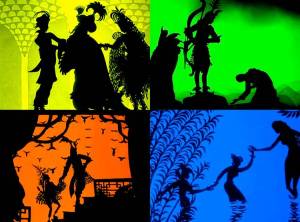
Eleven years before Walt Disney came up with its first animated feature film, The Adventures of Prince Achmed was made. The Adventures of Prince Achmed isn’t the first animated feature film made, but it is the oldest surviving animated film. Two other films, The Apostle and Without a Trace by Quirino Cristiani are considered to be lost.
The film uses Silhouette animation technique where the characters and other things appear dark while the background is light in color. The director of the film explains about how she animated her film using this Silhouette technique –
“…The technique of this type of film is very simple. As with cartoon drawings, the silhouette films are photographed movement by movement. But instead of using drawings, silhouette marionettes are used. These marionettes are cut out of black cardboard and thin lead, every limb being cut separately and joined with wire hinges. A study of natural movement is very important, so that the little figures appear to move just as men and women and animals do. But this is not a technical problem. The backgrounds for the characters are cut out with scissors as well, and designed to give a unified style to the whole picture. They are cut from layers of transparent paper.”
- Lotte Reiniger,Sight & Sound (1936).

The Adventures of Prince Achmed isn’t all about the effort put behind the animation and the technicalities. The story of the film is based upon the characters taken from different stories from the collection 1001 Arabian Nights and made into a fascinating tale on how Prince Achmed wins Princess Pari Banau from the evil African magician.
The film was full of imagination both in terms of story as well as the technique behind animation. Taking in different characters from different stories of Arabian Nights and making a good supernatural story with romance in it was a real treat. The film took 3 years to complete because of the animation technique, which required lots of effort to make the simple photographs of cardboard cutouts to appear in motion. The scenes are very much detailed and every movement is shown flawlessly and with lot of clarity. It was a lot more difficult to make the animation in those pre-computer days compared to today where we mostly make the animation digitally (I don’t mean digital animation is easy). It involved taking pictures of every frame of every movement a character or object is making and juxtapose them to make it appear in motion. Given that there are normally 25 frames a second, it means it required 25 different still photographs for every second of the film and putting them together with every photo differing very slightly from the previous one.
Read more from HERE

2 comments:
Very interesting read Cauli! I want to see the film now.
Tracing the history of this shadow puppet filming turned out to be interesting. I remembered seeing something about this in an exhibition at the National Gallery of Art in Washington DC on Toulouse-Lautrec and the Montmartre.
Turns out that cabarets (or night clubs) like the famous Le Chat Noir would have shadow plays as part of the entertainment.
Le Chat Noir (French for "The Black Cat") was a 19th-century cabaret in the bohemian Montmartre district of Paris. It was opened on 18 November 1881 at 84 Boulevard Rouchechouart by the artist Rodolphe Salis, and closed in 1897 (much to the disappointment of Picasso and others who looked for it when they came to Paris for the Exposition in 1900). Its imitators have included cabarets from St. Petersburg (The Stray Dog) to Barcelona (Els Quatre Gats).
Perhaps best known now by its iconic Théophile-Alexandre Steinlen poster art, in its heyday it was a bustling nightclub — part artist salon, part rowdy music hall. The cabaret published its own journal Le Chat Noir. It began as a small, two room affair, but within three and a half years its popularity forced it to move into larger accommodations a few doors down. Salis most often played, with exaggerated, ironic politeness, the role of conférencier (post-performance lecturer, or Emcee). It was here that the Salon des Arts Incohérents (Salon of Incoherent Arts), the "shadow plays" and the comic monologues got their start.
The Shadow plays themselves were brought by French Missionaries from China:
The show began to spread to Europe in the mid-18th century, when French missionaries in China took it back to France in 1767 and put on performances in Paris and Marseilles, causing quite a stir. In time, the Ombres chinoises (French for "Chinese Shadows") with local modification and embellishment, became the Ombres françaises and struck root in the country.[3]
The art was a popular entertainment in Paris during the 19th century, especially in the famous nightclub district of Montmartre. The tradition in France dates back to at least the mid-18th century when it was brought back by travellers to the Orient. The puppeteer Dominique Séraphin first presented the spectacle in Paris in 1776, and in Versailles in 1781.
The cabaret Le Chat noir ("The Black Cat") produced a number of popular Ombres chinoises shows in the 1880s, organized by the artist Henri Rivière, using up to 20 assistants and a large, oxy-hydrogen back-lit performance area. The Ombres evolved into numerous theatrical productions and had a major influence on phantasmagoria.[4]
One can imagine these shadow plays of the 1890s leading to the shadow animation technique you describe.
Thanks Pardesi for the info. Those plays might have inspired this particular form of animation.
The colorful backgrounds used in the film give the film a very imaginative look. The film has orange/red background in scenes which has fire, blue background for river scene, yellow for palace scene, etc.
Post a Comment